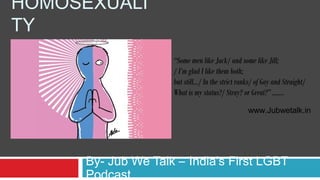Homosexuality - By Jub We Talk India's first lgbt podcast
- 1. HOMOSEXUALI TY By- Jub We Talk ŌĆō IndiaŌĆÖs First LGBT Podcast www.Jubwetalk.in ŌĆ£Some men like Jack/ and some like Jill; / IŌĆÖm glad I like them both; but stillŌĆ”/ In the strict ranks/ of Gay and Straight/ What is my status?/ Stray? or Great?ŌĆØ ŌĆ”ŌĆ”.
- 2. Sex and Gender ’é© Sex : Sex is something one is born with. ’é© An organism's sex is defined by the gametes it produces: males produce male gametes (spermatozoa, or┬Āsperm) while females produce female gametes (ova, or egg cells) ’é© 1) male 2) female 3) True hermaphrodites (have testes and ovaries) 4) Male pseudohermaphrodites (have testes, some aspects of female genetalia) 5) Female pseudohermaphrodites (have ovaries, some aspects of male genetalia) All societies have a set of gender categories that can serve as the basis of the formation of a┬Āsocial identity┬Āin relation to other members of society. In most societies, there is a basic division between gender attributes assigned to males and females. In all societies, however, some individuals do not identify with some (or all) of the aspects of gender that are assigned to their biological┬Āsex. Gender:
- 3. Human Sexuality : Human sexuality can also refer to the way someone is sexually attracted to another person - which is determined by their┬Āsexual orientation┬Ā- whether it is to the opposite sex (he te ro se xuality), to the same sex (ho m o se xuality), having both these tendencies (bise xuality),┬Āto all┬Āgender identities┬Ā(panse xuality o r bise xuality),┬Āor not being attracted to anyone in a sexual manner (ase xuality).
- 4. Sexual Orientation & Sexual Behavior ’éż Sexual orientation┬Ādescribes an enduring pattern of attraction that is romantic┬Āor┬Āsexual┬Ā(or a combination of these) to persons of the opposite sex, the same sex, or to both sexes, as well as the┬Āgenders┬Āthat accompany them.┬Ā ’éż Sexual identity┬Ārefers to how one thinks of oneself in terms of whom one is┬Āromantically┬Āor┬Āsexually┬Āattracted to. Sexual identity and sexual behavior are closely related to┬Āsexual orientation ’é© Sexual Behaviorrefers to the manner in which humans experience and express their sexuality. People engage in a variety of sexual acts from time to time, and for a wide variety of reasons.┬Ā
- 5. Homosexuality Homosexuality┬Ā is┬Āromantic┬Āattraction,┬Āsexual attraction┬Āor┬Āsexual activity between members of the same┬Āsex┬Āor┬Āgender. As an┬Āorientation, homosexuality refers to "an enduring pattern of or disposition to experience sexual, affectionate, or romantic attractions" primarily or exclusively to people of the same sex; "it also refers to an individual's sense of personal and social identity based on those attractions, behaviors expressing them, and membership in a┬Ācommunity of others┬Āwho share them."
- 6. Causes Of Homosexuality Source- Wikipedia
- 7. History Of Homosexuality in India The┬ĀArthasastra, an ancient Indian treatise on statecraft, mentions a wide variety of non- vaginal sexual practices which, whether performed with a man or a woman, were sought to be punished with the lowest grade of fine. While homosexual intercourse was not sanctioned, it was treated as a very minor offence, and several kinds of heterosexual intercourse were punished more ’é© The classic Indian text┬ĀKama Sutra┬Ādeals without ambiguity or hypocrisy with all aspects of sexual lifeŌĆöincluding marriage, adultery, prostitution, group sex, sadomasochism, male and female homosexuality, and transvestism. ’é© And once in a while, hidden in niches as in Khajuraho, one does find images of eitherwomen erotically embracing otherwomen ormen displaying theirgenitals to each other, the formerbeing more common (suggesting a tilt in favourof the male voyeur). ’é© Interpretations and judgements aside, these images tell us that the ŌĆśideaŌĆÖ of same-sex and what the colonial rulers termed ŌĆśunnaturalŌĆÖ intercourse did exist in India. One can only speculate if the images represent the common orthe exception.
- 8. Carvings at various Indian Temples Depicting Homosexuality
- 9. Myths About Homosexuality ’é© MYTH# 1 No one is born gay. ’é© MYTH# 2 Homosexuality can be cured/treated . ’é© MYTH# 3 People become homosexual because there was a deficiency in sex-role modeling by their parents. ’é© MYTH# 4 LGBT people don't live nearly as long as heterosexuals. ’é© MYTH# 5 Gay people are more prone to be mentally ill and to abuse drugs and alcohol. ’é© MYTH# 6 Same-sex parents harm children. ’é© MYTH# 7 Gay people can choose to leave homosexuality. ’é© MYTH# 8 Gay men molest children at far higher rates than heterosexuals. ’é© MYTH# 9 Homosexuality is a western concept ’é© MYTH# 10 Homosexuals are impotent males
- 10. Problems Faced By Homosexuals in India ŌĆóFear of disclosure of oneŌĆÖs sexual orientation and HIV status ŌĆóComing out to oneŌĆÖs family, friends (disclosing oneŌĆÖs sexual identity to friends and family) ŌĆóAnxiety, depression, suicidal behaviour are also the common concerns, particularly when they are HIV positive ŌĆóFear of disclosure of oneŌĆÖs sexual orientation and HIV status ŌĆóComing out to oneŌĆÖs family, friends (disclosing oneŌĆÖs sexual identity to friends and family) ŌĆóAnxiety, depression, suicidal behaviour are also the common concerns, particularly when they are HIV positive ’éż Confusion/conflation of sexual orientation with gender ’éż Dealing with pressures of marriage ’éż Discrimination at home/workplace and Society. ’éż Lack of social support systems
- 11. How Counselors Can Help ! ’é© Try and address your own discomfort with sexual practices, sexuality and sexual orientations ’é© Express a positive, open body language like smiling, nodding, concern, etc and understand verbal and non verbal cues ’é© Ensure privacy and confidentiality ’é© Be sensitive while asking questions ’é© Acknowledge clientŌĆÖs relationship and value them ’é© Encourage condom usage and explore other health issues ’é© Referrals to other counselors or therapists
- 12. Concerns And Challenges Helping the family to realize implications of the individualŌĆÖs sexual orientation(m arriage, child bearing, social consequence s) ’é© Dealing with issues related to oneŌĆÖs loneliness ’é© Sex and sexuality needs to be discussed in open forums Introducing curriculum on sexuality in universities ’é© Spreading Awareness About Homosexuality being natural among the people
- 21. www.Jubwetalk.in
- 22. www.Jubwetalk.
- 24. www.Jubwetalk.in
- 26. www.Jubwetalk.in
- 27. www.Jubwetalk.in
- 28. www.Jubwetalk.in































